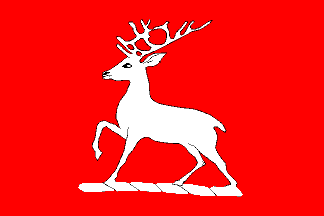 image
by Jarig Bakker,
based on the website of the National
Maritime Museum.
image
by Jarig Bakker,
based on the website of the National
Maritime Museum. 
Last modified: 2021-05-29 by rob raeside
Keywords: shipping lines |
Links: FOTW homepage |
search |
disclaimer and copyright |
write us |
mirrors
 image
by Jarig Bakker,
based on the website of the National
Maritime Museum.
image
by Jarig Bakker,
based on the website of the National
Maritime Museum.
From the website of the National
Maritime Museum, the house flag of Stag Line Ltd, North Shields. A red
rectangular flag with the crest of a white stag. The flag is made of a wool and
synthetic fibre bunting. It has a cotton hoist and is machine sewn with the
motif printed. A rope and toggle is attached. The design dates from 1846 when
the company purchased its first vessel, a wooden scow named 'Stag'.
The company was named after its first vessel 'Stag', purchased in 1846 by
Captain Joseph Robinson. He shortly afterwards formed a management company,
Joseph Robinson & Co. The company ran small wooden barques, buying their first
steam tramp in 1875 and going over entirely to steam by 1879. From 'Camelia' of
1858 onwards, the company tended to favour flower names for its vessels.
A limited company was formed in 1895 but the firm remained in Robinson's hands
and was based in North Shields. After some losses during both world wars the
company continued to trade worldwide, particularly to Canada. It was also
involved in cable laying in New Zealand and the West Indies. The company was
taken over by Hunting Gibson Ltd in 1981. The remaining coasters were sold by
1983 and the joint management company went to James Fisher & Sons of Barrow in
1982."
Jarig Bakker, 31 August 2004
Lloyd's Book of House Flags and Funnels (1912) shows the same house flag
(#787, p. 74).
https://research.mysticseaport.org/item/l011061/l011061-c008/39/
Ivan Sache, 27 April 2021
![[Stamp, Mann & Co.houseflag]](../images/g/gb~hfstm.gif) image by Ivan
Sache, 29 April 2021
image by Ivan
Sache, 29 April 2021
Lloyd's Book of House Flags and Funnels (1912) shows the house flag of Stamp,
Mann & Co. (#1194, p. 93), a Newcastle-based company, as white with a red cross,
charged in the center with a blue shield featuring a white anchor.
https://research.mysticseaport.org/item/l011061/l011061-c008/#58
Ivan Sache, 29 April 2021
![[Star Offshore Services Marine Ltd. houseflag]](../images/g/gb~sosm.gif) image
by Jarig Bakker, 28 October 2005
image
by Jarig Bakker, 28 October 2005
Star Offshore Services Marine Ltd., Aberdeen - white flag, blue disk charged
with white 5-pointed star, between two "S"-shaped blocks.
Source:
Loughran (1995)
Jarig Bakker, 28 October 2005
![[State Line houseflag]](../images/g/gb~stal.gif) image by
Eugene Ipavec, 9 August 2008
image by
Eugene Ipavec, 9 August 2008
This shipping company is presented on
The Ships List
website. It was a British company sailing to the US from 1872 onwards,
partly American owned, naming its ships after US states. A few years later
adverse circumstances led to ships being chartered out or even sold; the company
was finally wound up, Allan Line buying what was left of the fleet in 1891.
A poster on this page shows the house flag: a blue straight-edged swallowtail,
horizontally edged red above white (top) and white above red (bottom); on the
blue field is placed a white initial ‘S’ accompanied by a rather smaller white
star near the hoist. Shown here is the relevant part of a passenger list, ‘State
of Indiana’ New York to Glasgow offered on eBay (item no. 6597754753, ended 22
Jan. 2006). The date on the list I cannot read but according to the seller (“ocliners”)
it was issued in 1884.
While the ‘S’ recalls the firm’s name, the colours and the star are certainly
examples of mixed British and US flag symbology.
Additional information (sinking of the ‘State of Florida’):
http://www.norwayheritage.com/p_ship.asp?sh=stafl
Jan Mertens, 19 March 2007
![[State Line houseflag]](../images/g/gb~s1416.gif) image by
Neale Rosanoski, 4 December 2010
image by
Neale Rosanoski, 4 December 2010
State Line (State Steamship Co. Ltd). If one takes the flag image displayed
on the pamphlet on the theshipslist website then the flag may not have been as
long as its version is in the region of 1:2. The flag books vary. Lloyds 1882
shows a normal sized rectangular swallowtail but has a small star angled near
the top of the blue band in the hoist.
Neale Rosanoski,
4 December 2010
![[State Line houseflag]](../images/g/gb~s1417.gif) image by
Neale Rosanoski, 4 December 2010
image by
Neale Rosanoski, 4 December 2010
Griffen 1883 and 1895 have the flag tapered, the former showing less of an
angle to the star but having it bigger whilst Griffen 1895 has the star erect.
Neale Rosanoski,
4 December 2010
![[State Line houseflag]](../images/g/gb~s1418.gif) image by
Neale Rosanoski, 4 December 2010
image by
Neale Rosanoski, 4 December 2010
Reed 1891
is in line with theshipslist site with a small star but again keeps to the
standard size formula.
Neale Rosanoski,
4 December 2010
![[Italo Britannica houseflag]](../images/g/gb~stngh.gif) image by
Klaus-Michael Schneider,
29 May 2012
image by
Klaus-Michael Schneider,
29 May 2012
The flag is blue with a yellow Greek cross in the centre.
Source: [el1897 - Elbe Flag Chart 1897 – part 9; “Gratis Beilage zu Deicken und Behrmann’s Neuen Monatsheften Neue Ausgabe Sommer 1897"]
Klaus-Michael Schneider, 29 May 2012
![[Steamship Overdale Co., Ltd houseflag]](../images/g/gb~hfove.gif) image by Ivan
Sache, 1 May 2021
image by Ivan
Sache, 1 May 2021
The Steamship "Overdale" Co. was wound up voluntarily on 15 March 1916 (The
Edinburgh Gazette, 21 March 1916).
Lloyd's Book of House Flags and
Funnels (1912) shows the house flag of Steamship "Overdale" Co., Ltd (Babtie &
Co.) (#1607, p. 113), a Glasgow-based shipping company, as white with two blue
ascending diagonal stripes near the upper hoist and lower fly, respectively, in
the center a blue "O".
https://research.mysticseaport.org/item/l011061/l011061-c008/#78
Ivan Sache, 1 May 2021
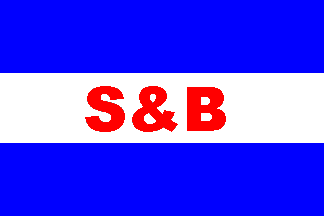 image
by Jarig Bakker,
based on the website of the National
Maritime Museum.
image
by Jarig Bakker,
based on the website of the National
Maritime Museum.
From the website of the National
Maritime Museum, the house flag of Steel and Bennie Ltd., Glasgow. A
rectangular blue, white and blue triband with the red letters 'S & B' across the
central white stripe. The flag is made of a wool and synthetic fibre bunting. It
has a cotton hoist and is machine sewn."
Jarig Bakker, 31 August 2004
![[Clanrye Steamship Co., Ltd. houseflag]](../images/g/gb~hfs&b.gif) image by Ivan
Sache, 24 April 2021
image by Ivan
Sache, 24 April 2021
The tug company Steel & Bennie was originally called the Glasgow & Greenock
Shipping Co and subsequently became Cory Ship Towage (Clyde), a member of the
Ocean Group.
https://www.theglasgowstory.com/image/?inum=TGSE01260
The Glasgow Story
Lloyd's Book of House Flags and Funnels (1912) shows the
house flag of
Steel & Bennie, Ltd. (Glasgow & Greenock Shipping Co.) (#452,
p. 58) as white with a red cross cantonned by the black letters "G", "R", "S",
and "C°.".
https://research.mysticseaport.org/item/l011061/l011061-c008/#23
Ivan Sache, 24 April 2021
![[Steel, Young & Co. houseflag]](../images/g/gb~hfsty.gif) image by Ivan
Sache, 3 May 2021
image by Ivan
Sache, 3 May 2021
Steel, Young & Co. was already mentioned in 1874, as the owner of the "Nith".
Lloyd's Book of House Flags and Funnels (1912) shows the house flag of
Steel, Young & Co. (#1717, p. 118), a London-based shipping company, as white
with the red letters "ST&Co" in the center.
https://research.mysticseaport.org/item/l011061/l011061-c008/#83
Ivan
Sache, 3 May 2021
![[G.M. Steeves & Co. houseflag]](../images/g/gb~hfgms.gif) image by Ivan
Sache, 26 April 2021
image by Ivan
Sache, 26 April 2021
Lloyd's Book of House Flags and Funnels (1912) shows the house flag of G.M.
Steeves & Co. (#688, p. 69), a Liverpool-based company, as red with a white "S".
https://research.mysticseaport.org/item/l011061/l011061-c008/34/
Ivan
Sache, 26 April 2021
![[Thos. Stephens & Sons, Ltd. houseflag]](../images/g/gb~hftss.gif) image by Ivan Sache,
28 April 2021
image by Ivan Sache,
28 April 2021
Lloyd's Book of House Flags and Funnels (1912) shows the house flag of Thos.
Stephens & Sons, Ltd. (#941, p. 81), a London-based company, as blue with the
white letters "T S & S" .
https://research.mysticseaport.org/item/l011061/l011061-c008/46/
Photo (National Maritime Museum)
https://collections.rmg.co.uk/collections/objects/1088.html
Ivan
Sache, 28 April 2021
Based on Sampson (1957).
James Dignan, 19 October 2003
Stephenson Clarke & Associated Co.'s, Ltd.
Description: blue with red St. Andrew's cross; white letters S&CCo in each
quarter.
Jarig Bakker, 19 October 2003
Stephenson Clarke. A slightly different version is shown by the 1933 Lloyd
Reedereiflaggen cigarette card collection replacing the letters "S&CCo" as shown
with "CS&Co" but nobody else supports this version. However the company which
originated as Stephenson Clarke & Co. in 1865 and became Stephenson Clarke &
Associated Companies Ltd. in 1928, in 1945 changed to Stephenson Clarke Ltd.
leading to a change in flag with the letters cut to "S" (hoist) and "C" (fly).
Since then the name has changed in 1968 to Stephenson Clarke Shipping Ltd. and
then in 2001 to Stephenson Clarke Shipmanagement Ltd. but I do not know whether
there were changes to the flag as a result.
Neale Rosanoski, 24 May 2004
![[Putford Enterprises Ltd. houseflag]](../images/g/gb~scs0.gif) image by Jarig Bakker, 3 October 2005
image by Jarig Bakker, 3 October 2005
Stephenson Clarke Shipping Ltd., Newcastle-upon-Tyne - blue flag, red
saltire; at hoist and fly white "SC".
Loughran (1995)
Jarig Bakker, 3 October 2005
The business was established by brothers Ralph and Robert Clarke during the
reign of King George II in 1730. Badly hit by the recession, the company went
into liquidation in 2012.
https://www.bbc.com/news/uk-england-tyne-19214386
BBC News, 10 August
2012
Lloyd's Book of House Flags and Funnels (1912) shows the same house
flag (#464, p. 59).
[with letters S&CCo]
https://research.mysticseaport.org/item/l011061/l011061-c008/#24
Photo of the house flag with letters "SC" (National Maritime Museum)
https://collections.rmg.co.uk/collections/objects/413.html
Ivan
Sache, 24 April 2021
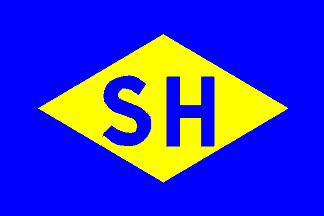 image
by Jarig Bakker,
based on the website of the National
Maritime Museum.
image
by Jarig Bakker,
based on the website of the National
Maritime Museum.
From the website of the National
Maritime Museum, the house flag of Stevinson-Hardy. A blue rectangular flag
with a yellow diamond in the centre bearing the blue letters 'SH'. The flag is
made of a wool and synthetic fibre bunting. It has a cotton hoist and is machine
sewn."
Jarig Bakker, 31 August 2004
Based on Sampson (1957).
James Dignan, 11 October 2003
Based in Glasgow, Scotland
Phil Nelson, 11 October 2003
![[Stewart & Esplen houseflag]](../images/g/gb~hfste.gif) image by Ivan
Sache, 3 May 2021
image by Ivan
Sache, 3 May 2021
Stewart & Esplen is mentioned by Roland Vernon ("The Constantine Group,
1885-2010") as "the most significant ship-brokering division of Constantine,
based in London from the 1950s".
Sir John Esplen (1863-1930) became
chairman of Esplen & Sons Ltd of Liverpool and Esplen, Son & Swainston Ltd of
London, and was a director of many other shipbuilding and shipping companies.
During the First World War he served as Director of Oversea Ship Purchase at the
Ministry of Shipping, and continued as Chief Professional Adviser into the
1920s. For his work for the Ministry of Shipping he was appointed Knight
Commander of the British Empire (KBE) in 1918 and created a Baronet in the June
1921 civil service honours.
Lloyd's Book of House Flags and Funnels
(1912) shows the house flag of Stewart & Esplen (#1663, p. 116), a
Liverpool-based shipping company, as swallow-tailed with slanted horizontal
edges, red with a white cross, charged in the center with a blue disk.
https://research.mysticseaport.org/item/l011061/l011061-c008/#81
Ivan
Sache, 3 May 2021
![[Stewart & Gray houseflag]](../images/g/gb~hfsgr.gif) image by Ivan
Sache, 12 March 2008
image by Ivan
Sache, 12 March 2008
Lloyds Book of House Flags and Funnels (1912)
shows the house flag of "Stewart & Gray" (#106, p. 42), a company based in
Glasgow (Scotland), as divided per saltire white-red-white-red, with the red
letters "S"and "G" in the left and right white triangles, respectively.
Ivan Sache, 12 March 2008
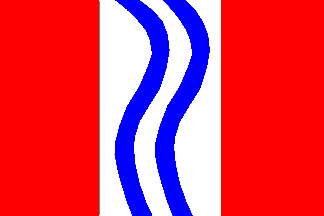 image
by Jarig Bakker,
based on the website of the National
Maritime Museum.
image
by Jarig Bakker,
based on the website of the National
Maritime Museum.
From the website of the National
Maritime Museum, the house flag of Stirling Shipping Co. Ltd., Glasgow. A
red, white and red tricolour flag. On the central white stripe, there are two
narrow, wavy vertical blue lines running parallel. The flag is made of a wool
and synthetic fibre bunting. It has a cotton hoist and is machine sewn. The
central motif is in polyester and cotton material. A rope and toggle is
attached. The wavy lines are said to represent the River Clyde. The flag is
similar to that of the associated company, Harrisons (Clyde) Ltd."
Jarig Bakker, 31 August 2004
![[W.H. Stott Ltd. houseflag]](../images/g/gb~whs.gif) image
by Ivan Sache, 21 April 2021
image
by Ivan Sache, 21 April 2021
Source: Brown's Flags and Funnels [Wedge 1926]
W.H. Stott, Limited, Liverpool - red swallowtail, white "S".
Jarig Bakker, 24 January 2005
W.H. Stott was born in 1835 into a family active in several aspects of port
services. He was apprenticed to the Liverpool shipbroking firm of Smith, Edwards
& Co., and in 1856 he joined Bahr Behrend & Co. as a chartering clerk. In 1860
he re-joined Smith, Edwards & Co. which, shortly after, took the title Allen &
Edwards. He became a partner in that firm in 1862 and the name of the firm was
altered to Edwards, Stott & Co.
In 1866 the firm of W.H. Stott & Co. was
established, obtained the sole agency for several important merchants, and in
1876 branched into shipowning with two sailing vessels. They acquired their
first steamer in 1886. About twelve vessels were owned over the next thirty
years employed in trade between the Mersey and Baltic ports. In 1894 one of
their vessels, the "Neva", was the first vessel to carry cargo (wood pulp) to
the port of Manchester via the Ship Canal before it was officially opened.
In
1895 Alfred Coker became a partner and the name of the firm was altered to
Stott, Coker & Co. This lasted three years until, in 1898, Coker left to set up
business as a shipbroker on his own account and the firm resumed its former name
of W.H. Stott & Co. A year later W.H. Stott (II) was admitted as a partner with
his father. The firm became a limited liability company in 1902 and two years
later W.H. Stott (I) died. The Stott Line Ltd. was formed in 1906 to take
control of the fleet, with W.H. Stott & Co. as the majority shareholder. The
Stott Line operated regular services from Liverpool and Manchester to Baltic
ports including St. Petersburg. In 1924 the line disposed of its last services
with chartered tonnage until its interests were acquired by Ellerman Wilson Line
of Hull, which adopted the style Ellerman’s Wilson & Stott Line in 1931.
W.H.
Stott & Co., Ltd. continued to act as agents, representing amongst others, the
Finland Steamship Co. and the Johnson Line of Stockholm. W.H. Stott & Co., Ltd.
was dissolved in 1994.
https://www.liverpoolmuseums.org.uk/artifact/w-h-stott-and-company-limited-shipowners-and-shipbrokers
National Museums Liverpool
Lloyd's Book of House Flags and Funnels
(1912) shows the same house flag (#102, p. 41).
https://research.mysticseaport.org/item/l011061/l011061-c008/#6
Ivan Sache, 21 April 2021
Based on Sampson (1957).
James Dignan, 8 October 2003
Houseflag: white burgee, blue border, top and bottom, with red, blue, red and
blue chevrons. Sailing: United Kingdom-Persian Gulf.
Jarig Bakker, 9 October 2003
Brown 195: Strick Line, Ltd., London.
Funnel: Black, a wide white band with four shortened chevrons pointing to the
viewers left, alternating from the left, red and blue.
Flag: 2:3, a forked white flag with blue borders along the fly-wise edges, four
shortened chevrons pointing towards the hoist, alternating red and blue. The
chevrons, together with the spaces between them that have the same width as the
bars of the chevrons, fill almost the entire depth of the flag. The chevrons and
the fork are all orthogonal. (It may be that the intention is that only a single
width separates the last chevron from the fly edges, but the print quality of
Browns' is not sufficient to be sure.)
James's images is more like:
Flag: 2:3, a forked white flag with blue borders along the fly-wise edges, four
shortened chevrons pointing towards the hoist, alternating red and blue. The
chevrons, together with the spaces between them that have the same width as the
bars of the chevrons, fill approximately half the depth of the flag. The fork is
orthogonal, the chevrons are obtuse.
Peter Hans van den Muijzenberg, 20 October 2003
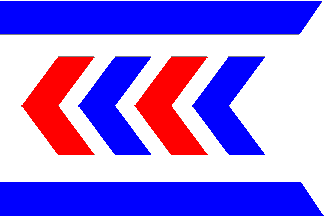 image
by Jarig Bakker,
based on the website of the National
Maritime Museum.
image
by Jarig Bakker,
based on the website of the National
Maritime Museum.
From the website of the National
Maritime Museum, the house flag of the Strick Line Ltd., London. A white,
swallow-tailed burgee with a blue border at the top and bottom edge. Four
chevron stripes, alternatively red and blue are placed across the centre. The
flag is made of a wool and synthetic fibre bunting. It has a cotton hoist and is
machine sewn. A rope and two Inglefield clips is attached.
The line was founded by Frank Clarke Strick (1849-1943), a Swansea businessman
with a background in coal exporting and shipbroking. He began his career as a
shipowner in 1887, his vessels carrying coal to the Mediterranean ports and the
Gulf and importing iron ore. By 1913, Strick's companies, La Commerciale Steam
Navigation Co. Ltd, The Anglo-Arabian and Persian Steamship Co. Ltd and
Anglo-Algerian Steam Ship Co. (1896) Ltd had all merged to form Strick Line Ltd.
The company was sold in 1919 and shortly afterwards became Strick Line (1923)
Ltd, a part of the P&O group. In 1946 the company name reverted to Strick Line
Ltd. In the post-war period the company traded worldwide, and in particular with
the Gulf States. It was taken over by P&O in 1972 and went out of existence in
1974."
Jarig Bakker, 31 August 2004
Regarding the variation in the shape of the Strick Line houseflag, the one I
remember while serving with them from 1958 until we were taken over by P&O is
this one with the fork taking the whole fly not just the white band and the four
chevrons occupying most of the white band. The Commodores pennant (see below)
was as per the small version found by Neale Rosanoski with the chevrons in line
in the upper canton at the hoist not staggered as in the other version (this I
do know as I was the 3rd. Mate on the 1960 Kohistan which was the first ship to
wear it!) The funnels had five chevrons which met at front and back starting
with red. This led to a typical crude seaman's description of "a kiss at the
front and a **** behind"! Two stories result from this - at the end of the war
all masters tried to find the paint to return their ships to their proper
colours, one even managed to paint the hull black not knowing that the company
had decided to retain grey, seemingly only one ship got the funnel correct. In
later years senior management heard of the description of the funnel above and
changed the last two ships to four chevrons per side so that they no longer met.
Only the cost involved stopped the whole fleet being changed!
Alasdair McCulloch, Master Mariner (Rtd.), 7 March 2007
Lloyd's Book of House Flags and Funnels (1912) shows the same house flag
(#565, p. 63) for Anglo-Algerian S.S. Co., 1896, Ltd. (F.C. Struck & Co., Ltd.).
https://research.mysticseaport.org/item/l011061/l011061-c008/28/
Ivan Sache, 25 April 2021
![[Frank C. Strick & Co. houseflag]](../images/g/gb~s732b.gif) image located by Neale Rosanoski
image located by Neale Rosanoski
Frank C. Strick & Co. Most sources, Talbot-Booth being the major exception, show
the fork taking all of the fly rather than just the white band. All usual
sources agree that the chevrons occupy most of the band. The funnel view given
only applies to the port view, starboard also shows the chevrons pointing
forward. The company had a commodore's flag being a white tapered swallowtail, a
red cross and in the canton the four red-blue chevrons. The company was absorbed into P&O (owners from 1919) in 1972 and
although P&O appear to have used their name for registering ships until the
early 1980s I understand that the flag was not used after 1972.
Neale Rosanoski, 24 May 2004
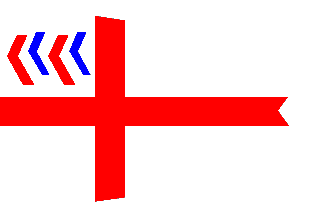 image
by Jarig Bakker, 28 December 2004
image
by Jarig Bakker, 28 December 2004
Strick Steamship Co. Ltd. Commodore's flag - white tapered swallowtail, red
cross; in canton four chevrons RBRB note: Commodore's flag is flown separately
from the ordinary flag, from the foremast.
From Scott, R.M., The Caltex book of Flags and Funnels, Capetown, Caltex Africa
Ltd. (1959).
Jarig Bakker, 28 December 2004